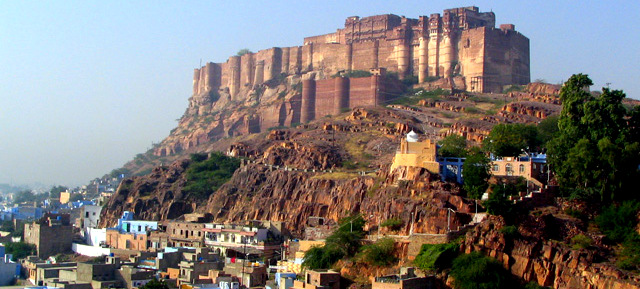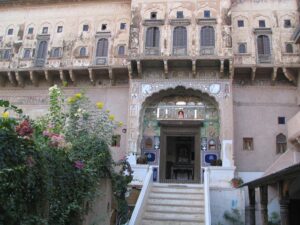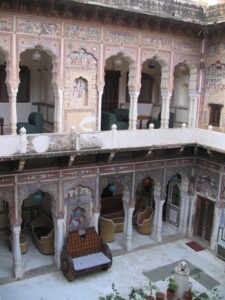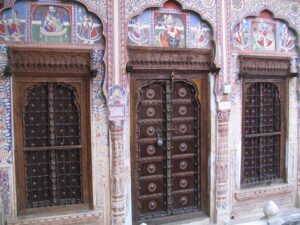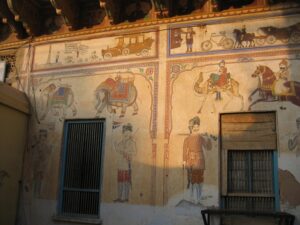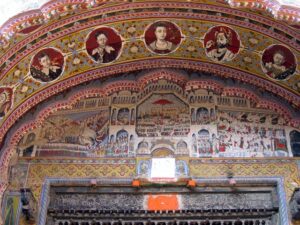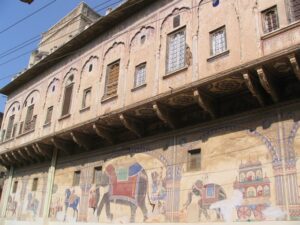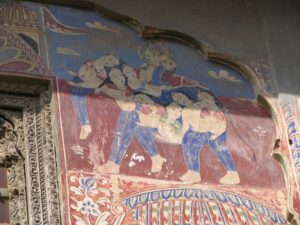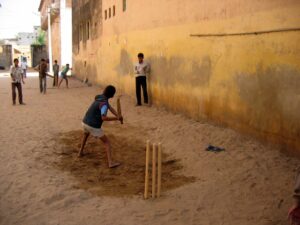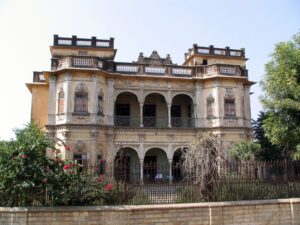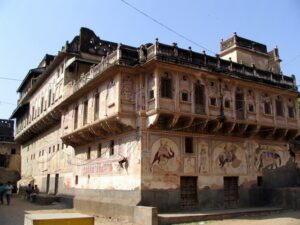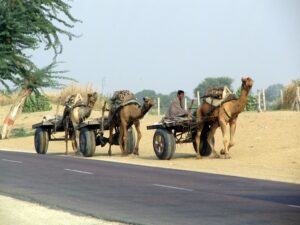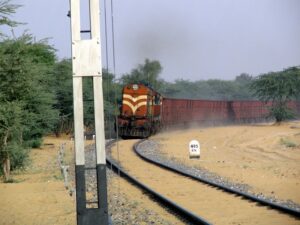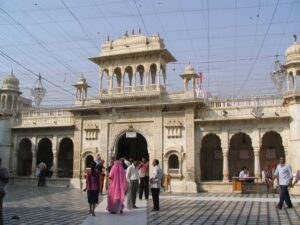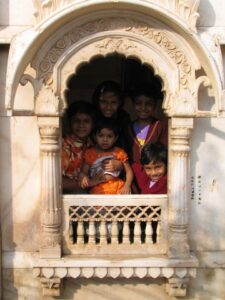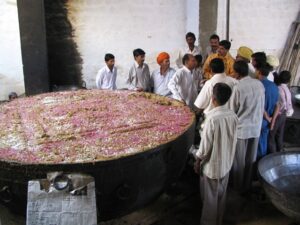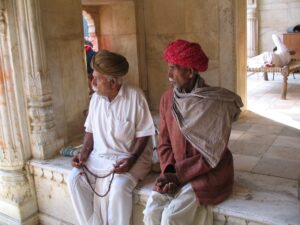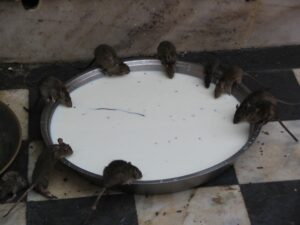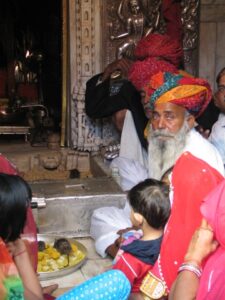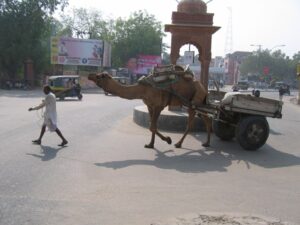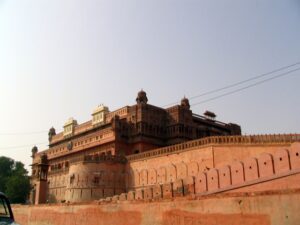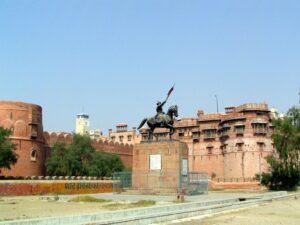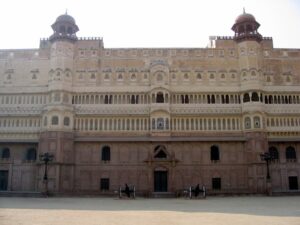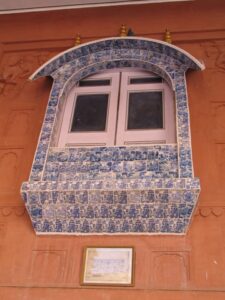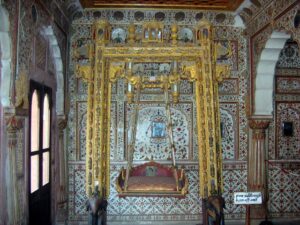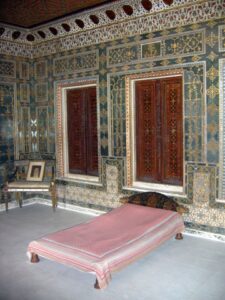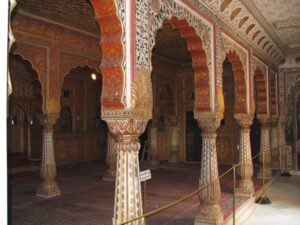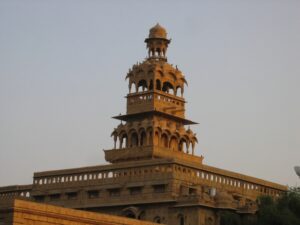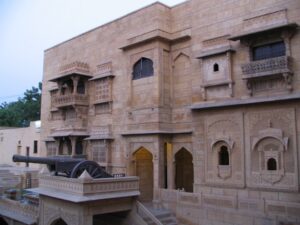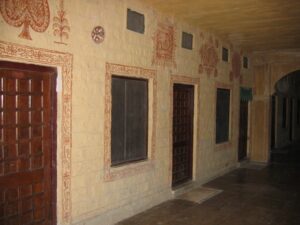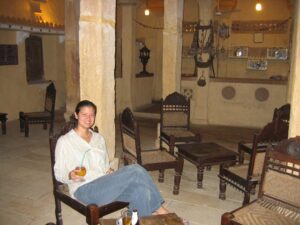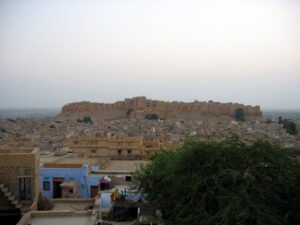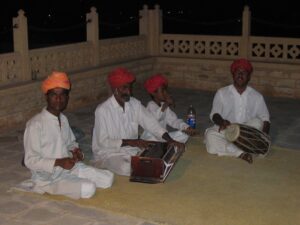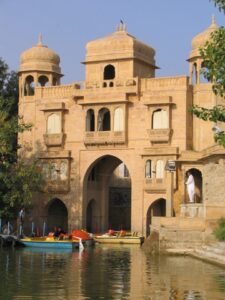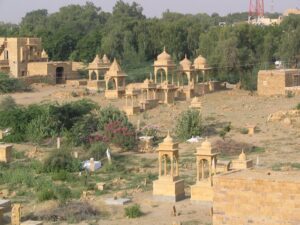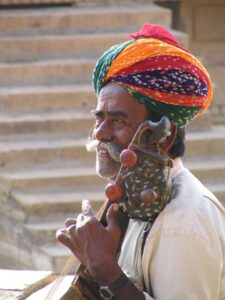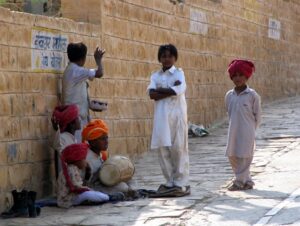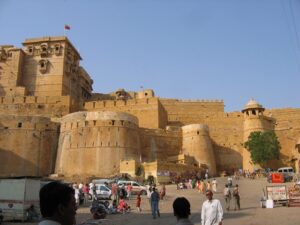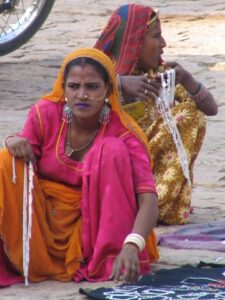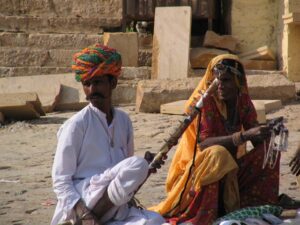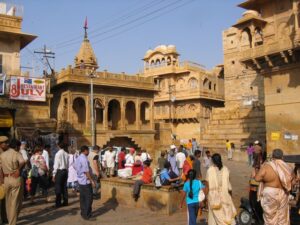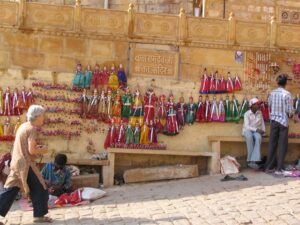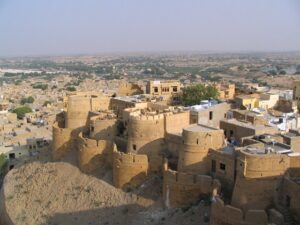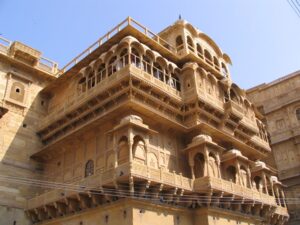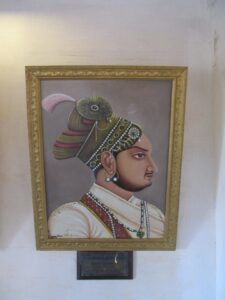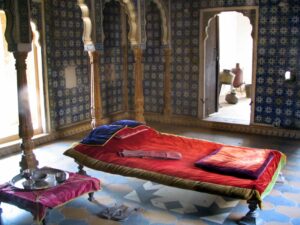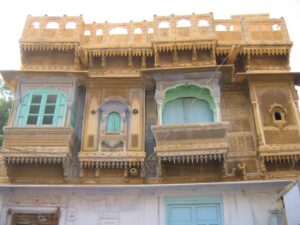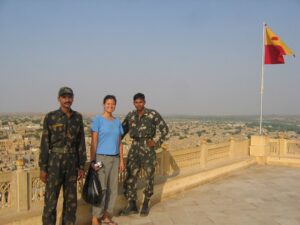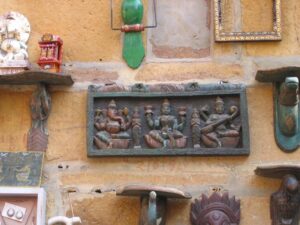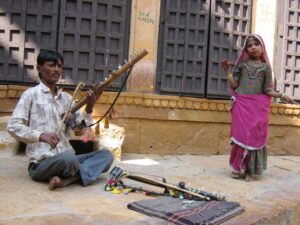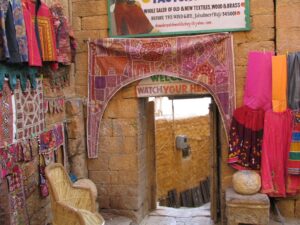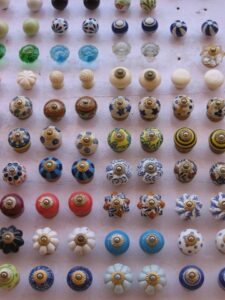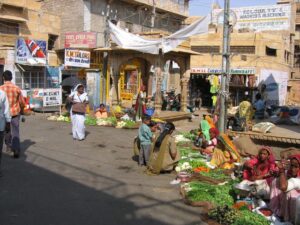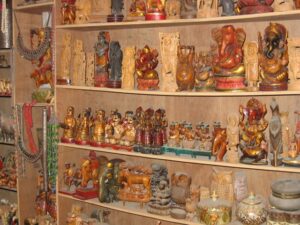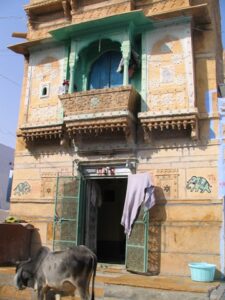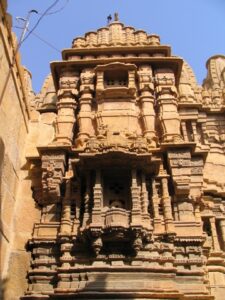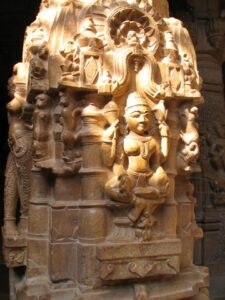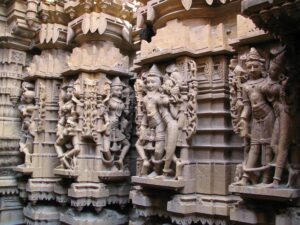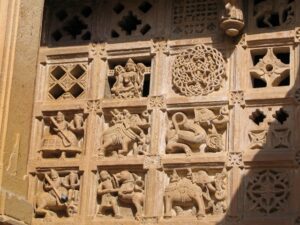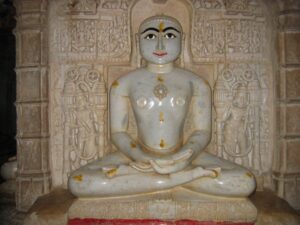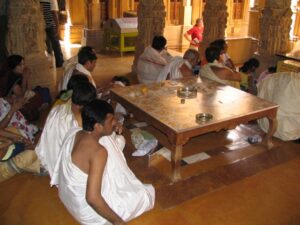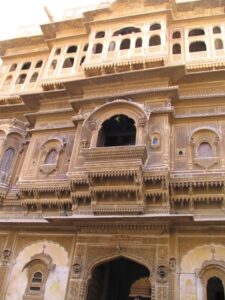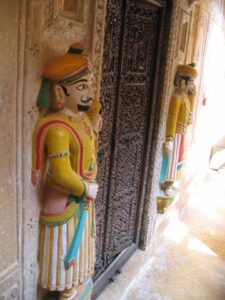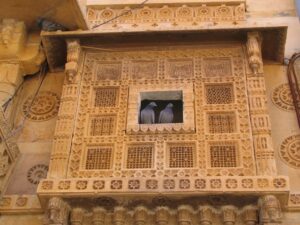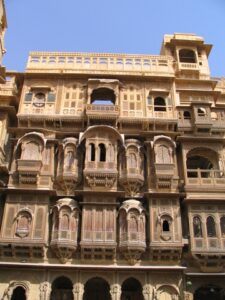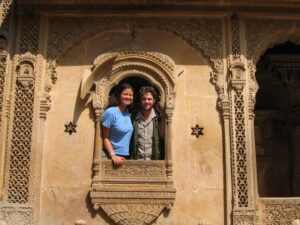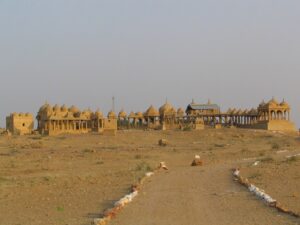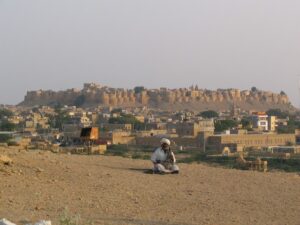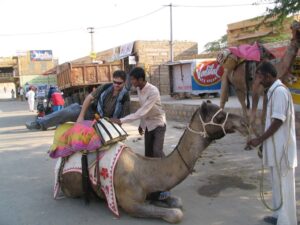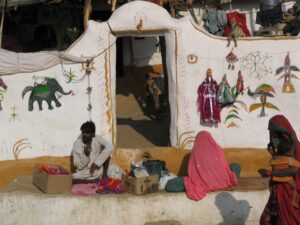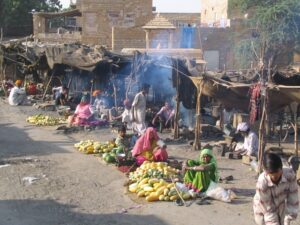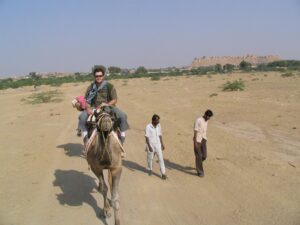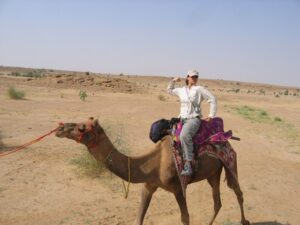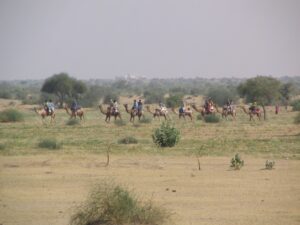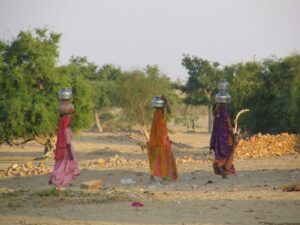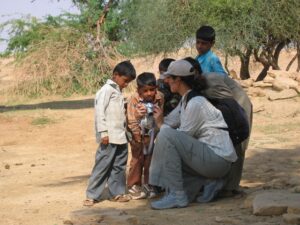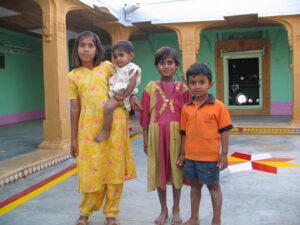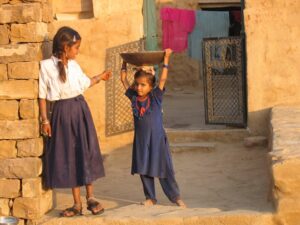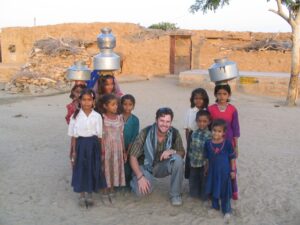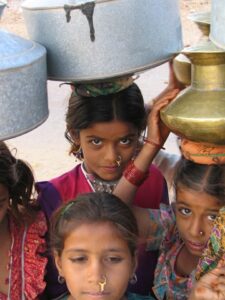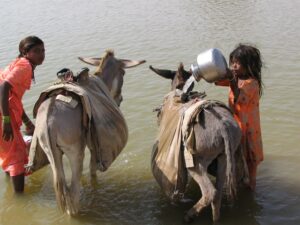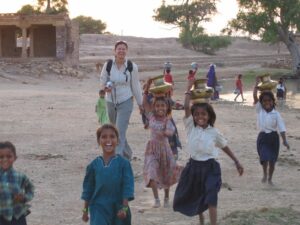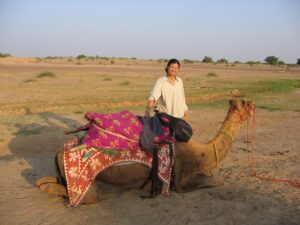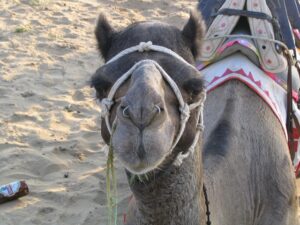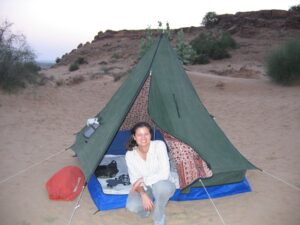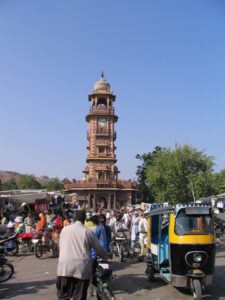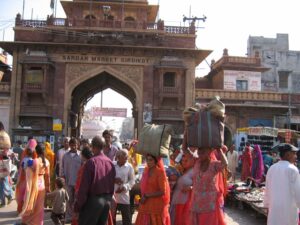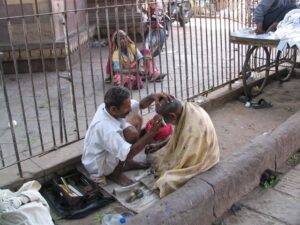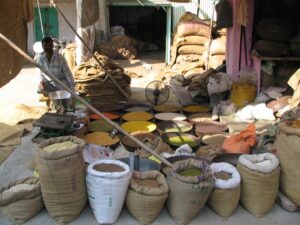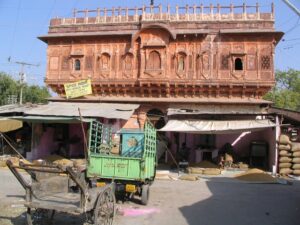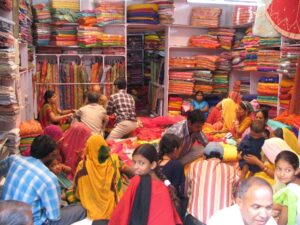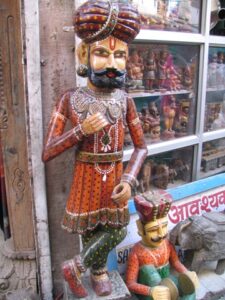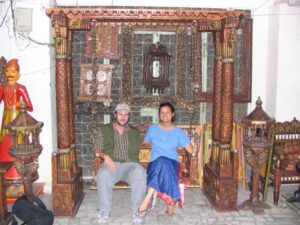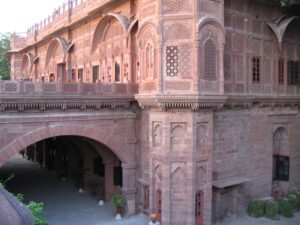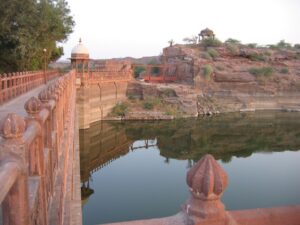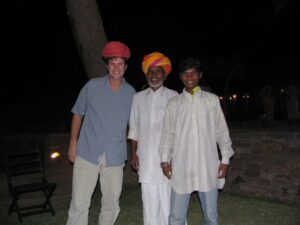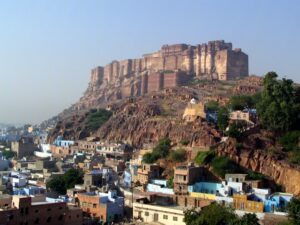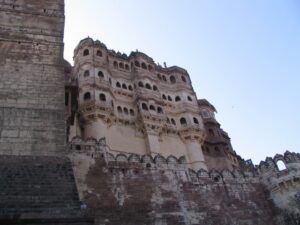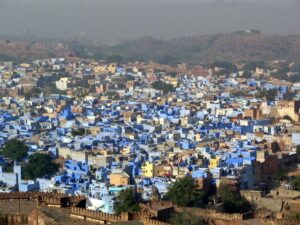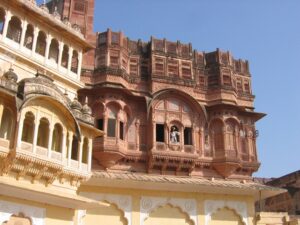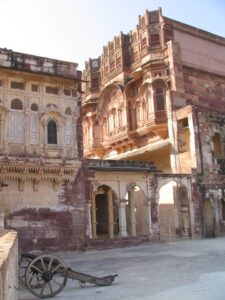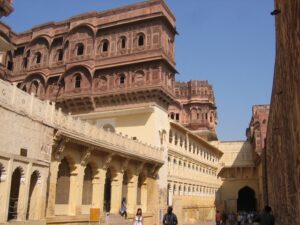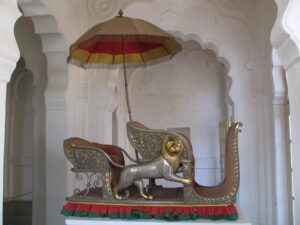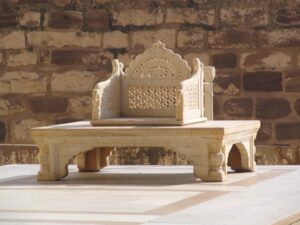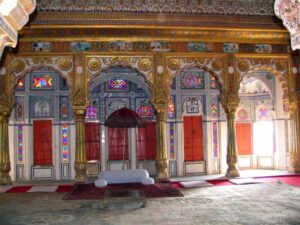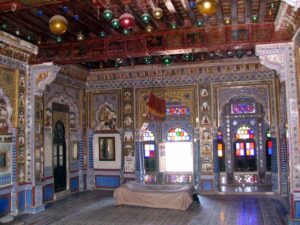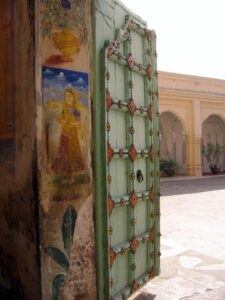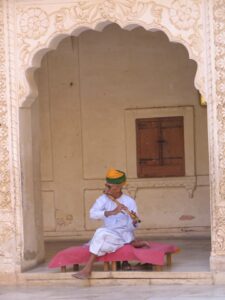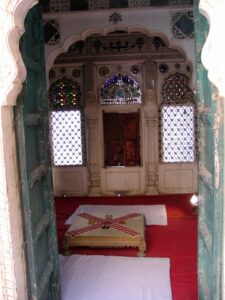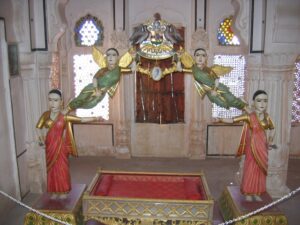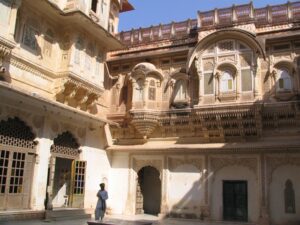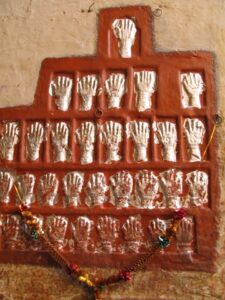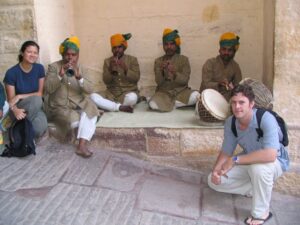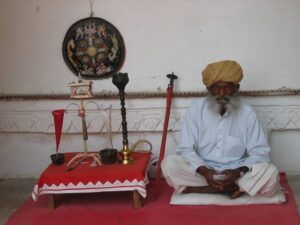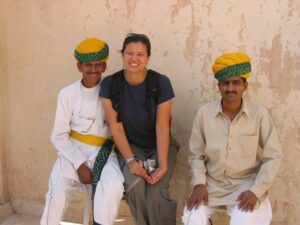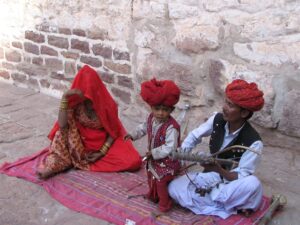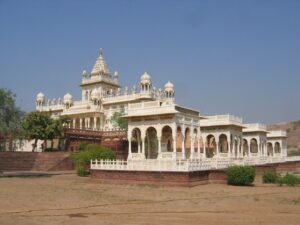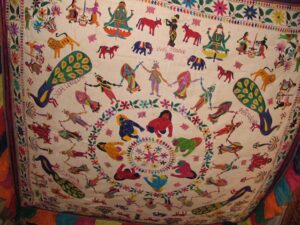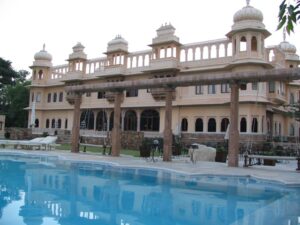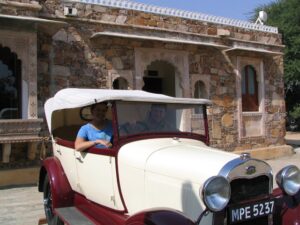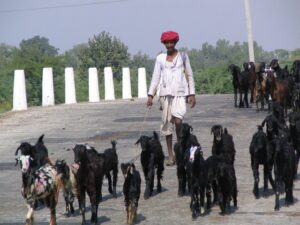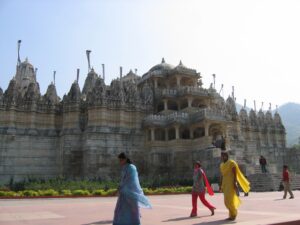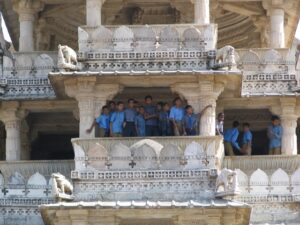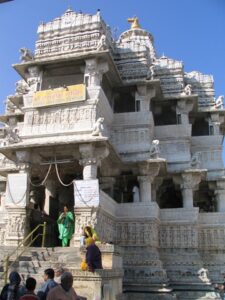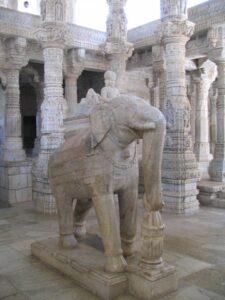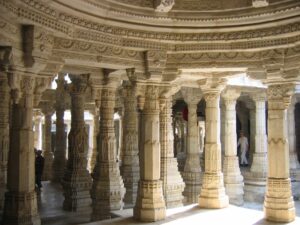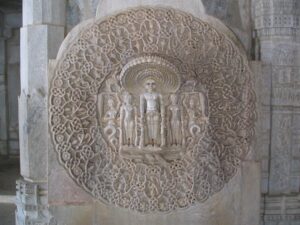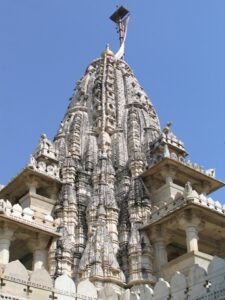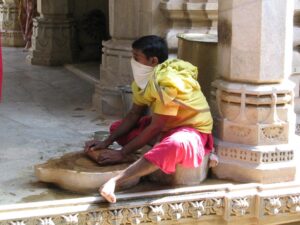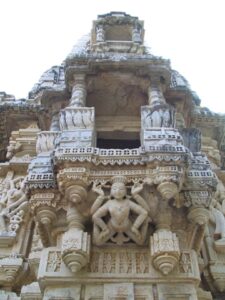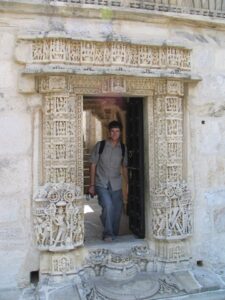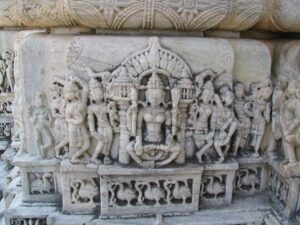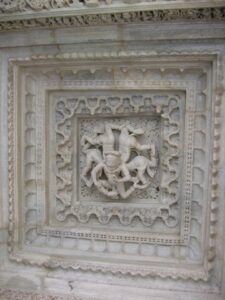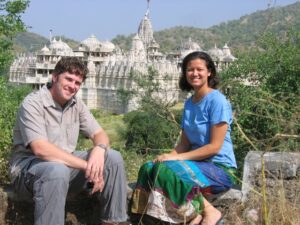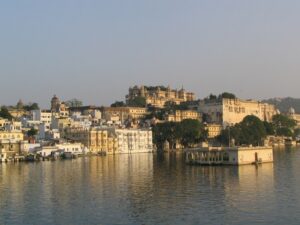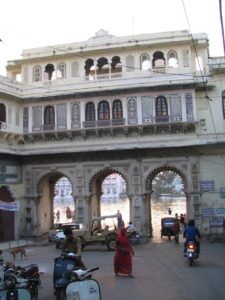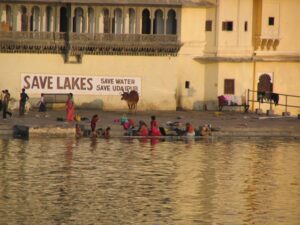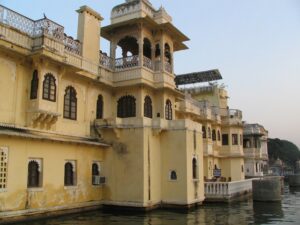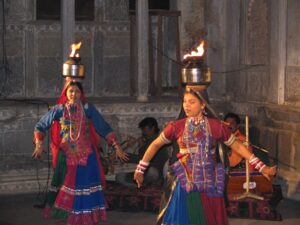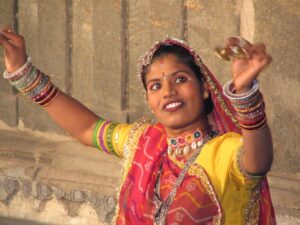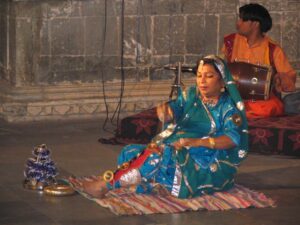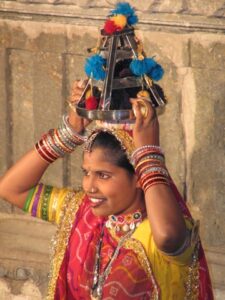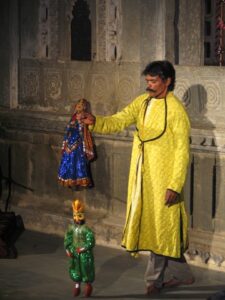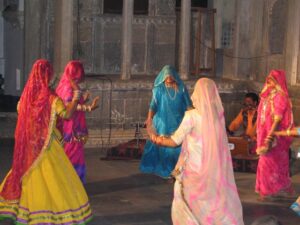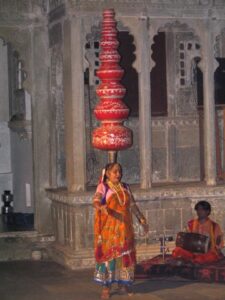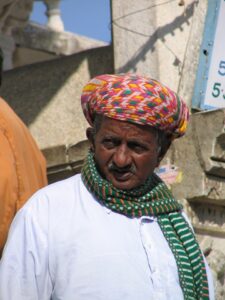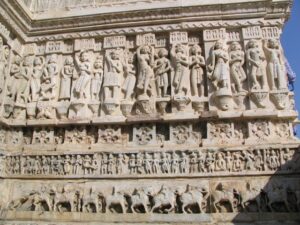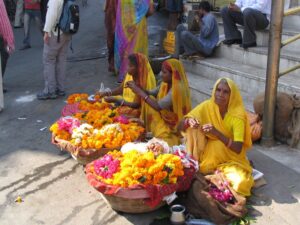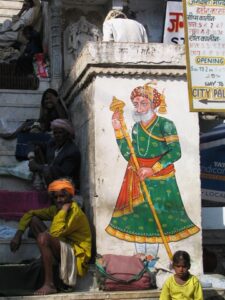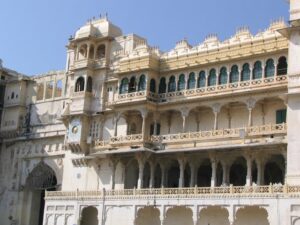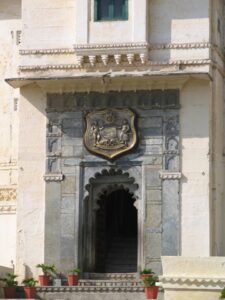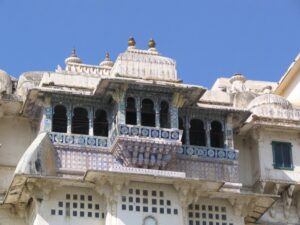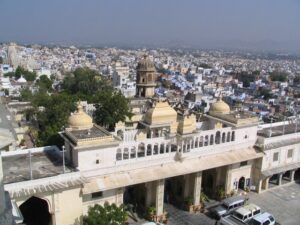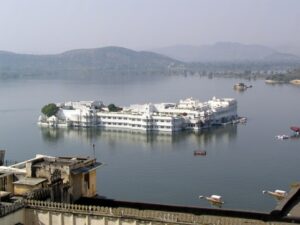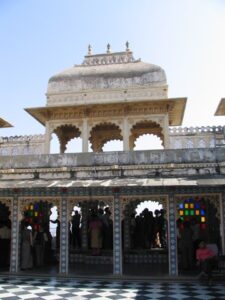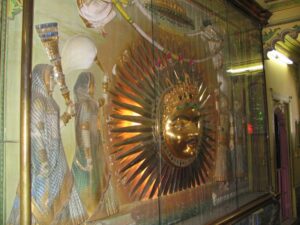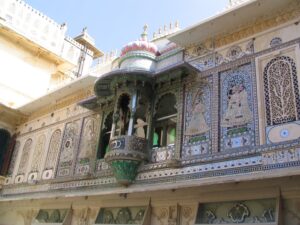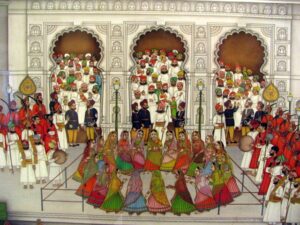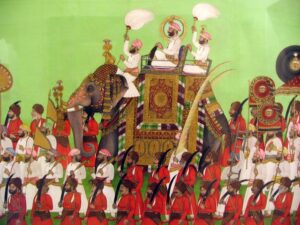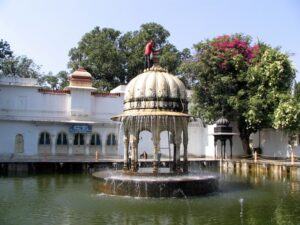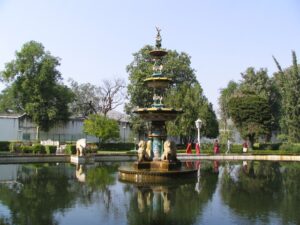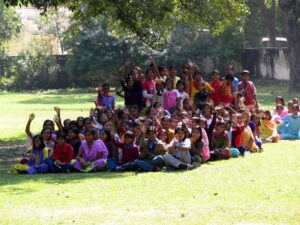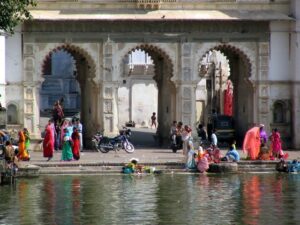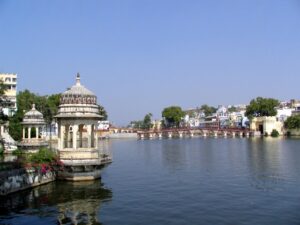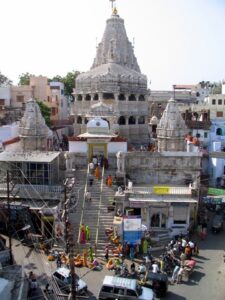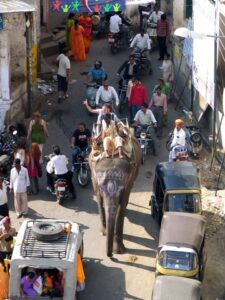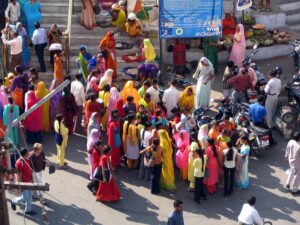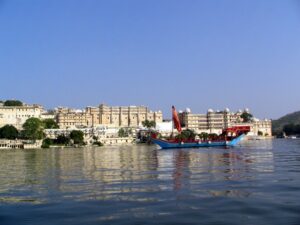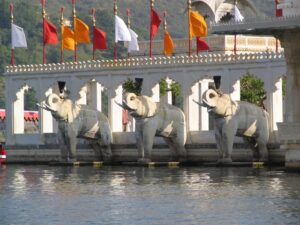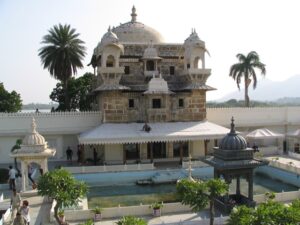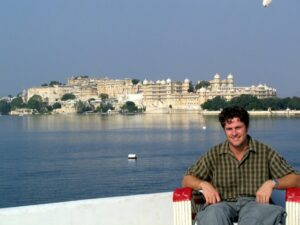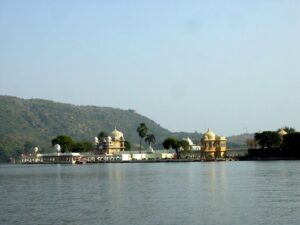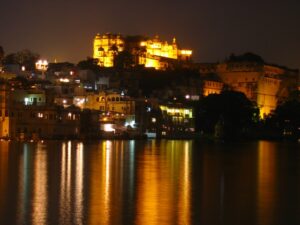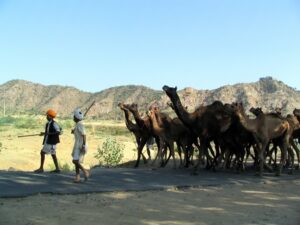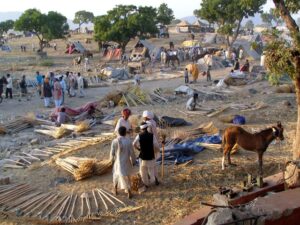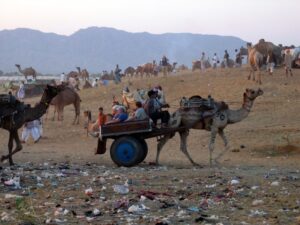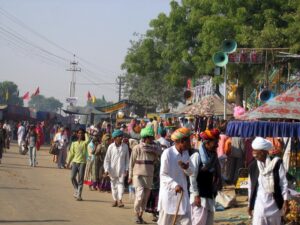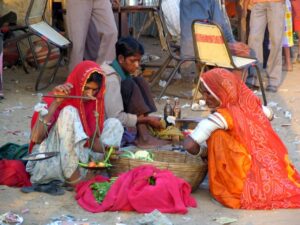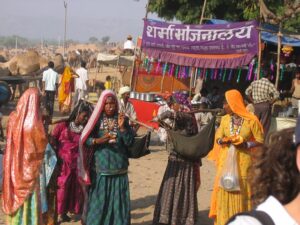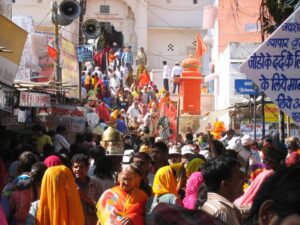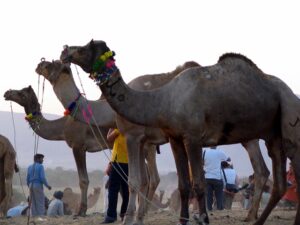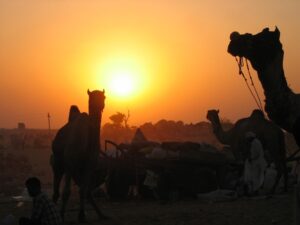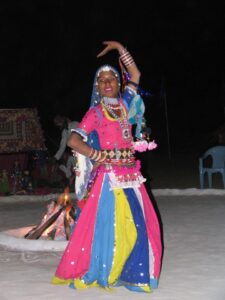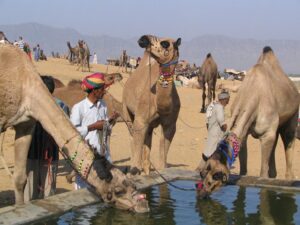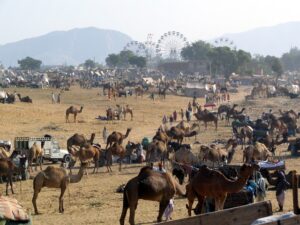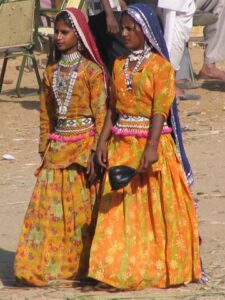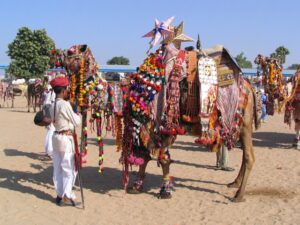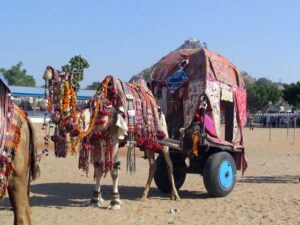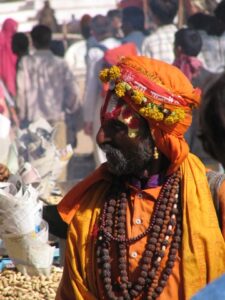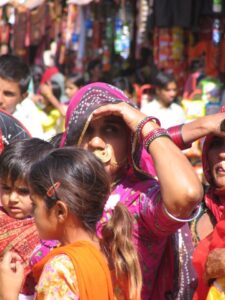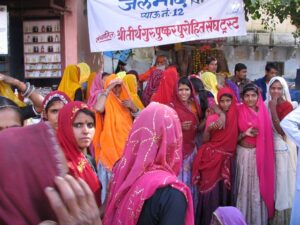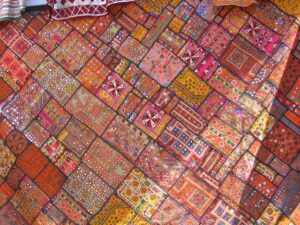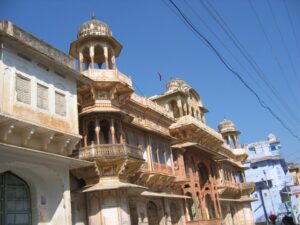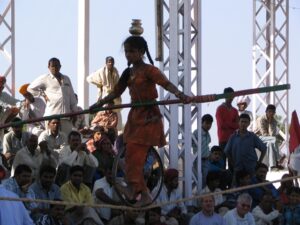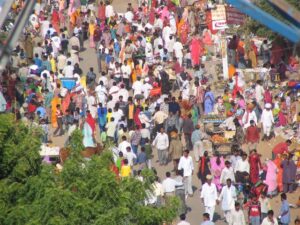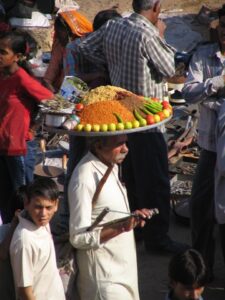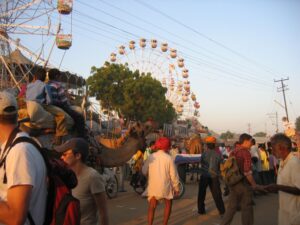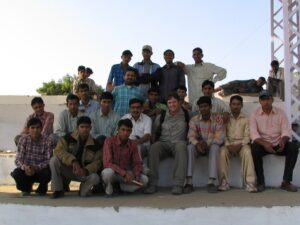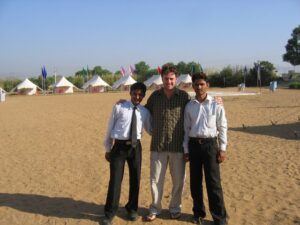The Pushkar Camel Festival is perhaps Rajasthan’s most famous tourist draw card. Surging numbers of tourists and locals totaling almost a quarter of a million converge on the tiny town of Pushkar (a holy Hindu town) for the colorful and lively affair. But we had more to explore than just Pushkar, and were excited about seeing the rest of Rajasthan’s gorgeous forts, palaces, and architecture. Our itinerary included the amazing havelis of Shekhawati (Mandawa and Nawalgarh), the Junagadh Fort of Bikaner, and the fear-factor inspired Karni Mata temple (picture thousands of holy rats!), Jaisalmer’s mesmerizing fort and havelis, a camel trek out into the Great Thar Desert, Jodhpur’s Mehrangarh Fort and Jaswant Thada, Ranakpur’s phenomenal Jain temples, a boat ride on Lake Pichola in romantic Udaipur (scene for the James Bond movie “Octopussy”), and finally, joining the vibrant and noisy mosh pit of Pushkar’s amazing camel festival.
4 November: Unfortunately, Ariana Afghan Airlines was operating under normal circumstances, so we arrived into New Delhi an hour later than expected. We were met by a local Indian Holiday representative who gave us all our hotel and service vouchers, and answered our last minute questions. Time was of the essence, however, since we had agreed to a long drive from Delhi to Mandawa this afternoon. So after the brief pleasantries, we were escorted out to the parking lot, where we met our driver, Naranda, and were on our way. We chose Indian Holiday (www.indianholiday.com) as our travel organizer after scouring the massive selection of various Indian tour operators. Ms. Pooja was quite prompt and honest in her advice, and we catered an itinerary taking in the highlights of Rajasthan as well as hitting the famous Pushkar Camel Festival. Driving in India is absolutely insane. The best advice we can give anybody visiting for the first time is to trust your driver and try to close your eyes (India is no place to be a back-seat driver)! Expertly weaving in and out of traffic, dodging cows and huge trucks, our speedy vehicle made progress along the difficult journey from Delhi to Mandawa. We estimated it took us about 7 hours to get there, including a dinner stop. Mandawa is a great base for exploring the Shekhawati region’s beautiful havelis. We didn’t know what was special about this region’s havelis, but quickly found out once we hit Mandawa. Our hotel was the gorgeous Hotel Mandawa Haveli (located a few meters before you reach Sonathia Gate), where we wearily climbed up to our room. To our pleasant surprise, we found that we had been booked into the amazing suite, which blew us away with its gorgeous décor, window seats, antiques, and rich, colorful paintings. The Mandawa Haveli definitely earns two thumbs up! (To book, email at hotelmandawahaveli@yahoo.com or res_haveli@yahoo.co.in)
5 November: We woke up mesmerized by our haveli hotel’s amazing frescoes. A haveli is a traditional ornately decorated residence, and many have been converted into hotels in an effort to bring in enough dollars to preserve these works of art. We read in our LP guidebook that the rich colors decorating the haveli’s walls were an effort to ward off loneliness and bring more color to a parched desert landscape. They were also a very effective way at boasting of the owner’s premier economic status! We ate a quick breakfast of masala omelette and toast, before heading out into Mandawa to check out its sights. First stop was the State Bank of Bikaner (Binsidhar Newatia Haveli) where we laughed at the paintings depicted on the walls! Scenes of the Wright brothers attempting flight, and a boy using a telephone seemed a bit out of place next to the elephants and camels led by uniformed men. Mandawa was starting to get crowded with tourists by early morning, so we decided to head out towards Nawalgarh for some more havelis. Poor Naranda got confused, and started to drive us directly to Bikaner. But Becky caught on after checking out our heading on the map, and forced us to backtrack towards Nawalgarh. Once we ironed out the confusion, we reached Nawalgarh by 10 am, and hired a local guide for 100 RS to show us around the town. We started our tour at the Bansidhar Bhagat Haveli, and our guide explained that Nawalgarh’s haveli owners are too proud to convert their precious homes into hotels. Therefore, most of the havelis have that slow, decaying look and the town itself is referred to as Shekhawati’s best open air gallery. Walking down the streets leading away from the banyan-tree shaded center, we admired the amazing paintings, and beautifully carved wooden gates that gracefully decorated most buildings in the city. The murals are worth spending some time with, as many of them are decorated not only with paint, but also small pieces of mirror, gold and silver. We finished our tour at the Aath Havelis (8 Havelis), which had steam-engine trains, and European visitors in traditional 19th century dress. Young boys were eagerly playing cricket in the center of the complex, and our star-struck gazes of the havelis didn’t interrupt their game at all! They simply played around us. Afterwards, we linked back up with Naranda, for our onward drive to Bikaner. Thankfully, there is a highway (11) that linked us to Bikaner on smooth roads only 150 km away. So we made good time and pulled into the gaudy Karni Bhawan Palace Hotel shortly before 5 pm. We were greeted by the Indian Holiday representative, who assured us that we would start our tour in Bikaner tomorrow morning early enough to see the Karni Mata Temple (Rat temple), as well as Junagadh Fort. We checked into our suite room, which was huge! Too bad the palace was decorated in ugly art-deco style (dictated in the 1930s by the last ruling Maharaja of Bikaner, whose black and white photos served as wall décor). Apparently Maharaja Karni Singh was a 1964 Tokyo Olympic medal marksmen, and used the surrounding area as his hunting ground…the area has since been sold off to locals in an effort for the current owners to make ends meet. The palace was converted into a hotel in the early 1990s, and tonight it was packed with German tourists. We joined everyone in the dining room, starting off with cocktails before being served dinner. The attentive waiters prided themselves on their service, and we were constantly reminded that India is one of the best customer service-oriented countries in the world!
6 November: This morning we met our local Bikaner guide who informed us that today was our lucky day. Of all days, today was one of the most auspicious to visit the Karni Mata Temple as we would be joining thousands of devotees paying their respects at the rat temple. Over 1,500 KG of sweet porridge would be cooked for the thousands of pilgrims anticipated to visit the temple today. What did this mean for us? Little did we realize but today was one of the only days of the year where humans might actually outnumber rats at the Karni Mata! With so many human visitors, the rats would seek refuge underground, allowing us safe passage (sans rats) to actually venture inside and walk around the entire temple complex. It is a bit bizarre to see thousands of rats being devoutly worshipped. It is even more disconcerting to have them scramble about your feet as if you don’t even exist! Indeed, once you venture inside the Karni Mata Temple, you have definitely entered into the rats’ domain! We spent just enough time at Karni Mata not to get too grossed out, and then headed back into Bikaner for a visit to the Junagadh Fort. On our journey back to Bikaner, our guide explained that Bikaner has three main sources of livelihood. The primary is the spinning of textiles (Oxfam funded), followed by the Army (since Bikaner is relatively close to neighboring Pakistan), and lastly, the sandstone mines providing Bikaner with beautiful hues of red sandstone. Nowhere is the red sandstone more evident that the Junagadh Fort, which was built in the late 1500s by Raja Rai Singh, who served as a general in Akbar’s Mughal Empire. We entered through the Surajpol (Sun Gate), and were given a briefing on the fort’s amazing stone carvings and decorated interiors. In fact, our local guide boasted that Junagadh was the finest in all of India, especially for its miniature-style paintings and exquisite artwork. After wandering through to admire the various palaces, courtyards, balconies, and windows, we were ready to see what else Bikaner had to offer. Of course the obligatory stop at an esteemed miniature-painting specialist and handicrafts workshop were arranged, but we were focused more on our itinerary which promised a visit to the Bhand Sagar temple. To our dismay, our guide told us that since we didn’t mention it earlier this morning, we’d have to miss out since it was not convenient to backtrack and include it. But, he readily assured us, Jaisalmer’s Jain Temples were indeed a sight to behold, and we weren’t missing much by skipping Bhand Sagar. We’ll never know, however, so we chalked this morning’s experience as a “lesson learned” (always ask the tour guide what will be included on the day’s tour!) and continued on towards Jaisalmer. Jaisalmer’s hype preceded it. We had read that the city “looks as if it has grown out of the desert. Like a giant sandcastle, its golden fort thrusts skywards out of the surrounding barren landscape. Dubbed the Golden City because of its honey color, it is a place that should exist only in the imagination. And the sensation of having entered a storybook doesn’t stop when you enter the gate. Within the fort walls are winding labyrinthine streets and bazaars, lined by exquisitely complex temples and havelis – it is a living and breathing home to several thousand people. Outside the fort, the narrow streets of the city are magical, lined by elegant havelis that look as if they have been carved from sand”. Wouldn’t such a magical description of that inspire you to visit Jaisalmer? Naranda struggled to find our hotel, which we had gotten out of the travel book “1000 Places to See Before You Die”. Eventually, he was given accurate directions to the Narayan Niwas Palace Hotel, which is tucked away in a niche in a corner of the city. Within easy walking distance of the fort, we later on realized that we would have preferred to stay within the fort’s walls, as Jaisalmer Fort is indeed very romantic! We were greeted by the local Indian Holiday representative, George, who discussed our camel safari plans on our last day in Jaisalmer. He did not realize that we had also organized a city tour, and after producing our service voucher as proof, agreed to send a guide to meet with us the next morning. After verifying that the city tour itinerary would meet our expectations, we found out that instead of the Sam Sand Dunes Camel safari, we would be taking a “less touristy” version that would take us approximately 20 KM from Jaisalmer. A bit disappointed that we would not see the undulating sand at the sand dunes, we agreed to the change in plans since we had read how touristy Sam Sand Dunes had become, and didn’t want to compete with dozens of other camel safari clients. After checking into our room, we headed upstairs to the rooftop for an amazing view of Jaisalmer Fort as the sun was setting. It is amazing that a city like Jaisalmer can exist in the world today…and we weren’t surprised to hear that tourism to this special area has caused a whole slew of new problems (infrastructure issues, open drains, poor plumbing, etc). Enjoyed drinks at the bar downstairs, before heading back up to the roof for live music and a dinner buffet.
7 November: Unfortunately, the Narayan Niwas Palace Hotel rests entirely on its past laurels (and its mention in the 1000 Places to See Before You Die bestseller), as we found out during breakfast this morning. It was dismal…way too many customers clamoring to be fed (by an empty buffet), understaffed, and lousy service. We vowed to eat a better lunch instead, and took off for our day’s tour. Our guide took us directly to the Gadi Sagar, where we joined throngs of other tourists in checking out the water tanks south of the city. Some guides urged their clients to purchase some bread, which was thrown into the water, and quickly gobbled up by massive catfish! We have never seen such monstrosities before, but these mutant catfish reigned supreme at the Gadi Sagar. We heard an interesting tale about the Tilon-ki-Pol gate that was built by a famous prostitute. She paid an exorbitant sum to have the gate built, but the maharaja was upset because he would have to pass under the structure each time he went down to the water tank. So after he threatened to have it torn down, she craftily hired some workers to build a Krishna temple the night before the destruction. To the maharaja’s horror when he awoke the next day, he realized that the prostitute has outsmarted him, and the structure would have to stay (it would have been sacrilege to destroy a Krishna temple!) Afterwards, we made a brief stop at a nearby museum, where a guide immediately latched on to us and proceeded to give us a very in-depth briefing on the simple artifacts on display. The self-immolation display that widows were forced/coerced into (commonly called Sati) especially disturbed Becky since the photos and captions seemed to glamorize this horrible practice, and make it sound as if the widows were doing it of their own free will! Yeah right, and if you believe that, I’ve got beachfront property in Kabul to sell you! Afterwards, we headed back to Jaisalmer, where Naranda could only bring us as far as the Fort’s outer limits. We had to walk the rest of the way in, but we weren’t complaining! The atmosphere through the main entrance of the fort (there were 4 main gates) was electric, with musicians, dancers, puppeteers, shopkeepers, and a motley of other traders all vying for our attention! It was great, and we took our time slowly strolling up the main pathway to the center of the fort. Jaisalmer really does live up to its famous reputation, and we quickly kicked ourselves for not knowing that the more scenic option would have been to lodge within the fort’s walls. The balconies of Jaisalmer are so intricately carved that we found ourselves paying more attention to them than dodging the cow-dung land mines that are haphazardly strewn along the narrow alleyways. The Jain temples of Jaisalmer are absolutely phenomenal. After paying for our entrance/camera tickets, we duly took off our flip-flops and walked barefoot into the complex. Its sheer size was astounding, and it seemed like every inch of the columns, walls, and ceiling were adorned with carved figurines. Absolutely amazing! And it’s a living, worshiping complex, so we had to compete for space with Jain devotees, who made rice offerings that were unintentionally crushed beneath our footsteps. We spent well over an hour wandering through the complex of temples, before linking back up with our guide, who escorted us to some of Jaisalmer’s finest havelis, the Nathmal-Ki-Haveli, and the Patwon-Ki-Haveli. The Nathmal Haveli was pretty neat, and our guide recommended that we sit down by a bench beside the Haveli to admire the handy-work of the building. Built by two brothers, the building looks symmetrical at first glance. However, with a little bit of concentration, our guide pointed out the differences that make each half of the building unique. Very cool…the inside of the haveli has been converted into shopping stalls, so we wandered in for a quick glance before heading over to the Patwon-Ki-Haveli. Wow…the Patwon is absolutely amazing! Five Jain brothers (wealthy from trafficking opium) built these monstrosities to show off their wealth. And what gorgeous buildings…one has to squeeze down a narrow lane, and peer upwards to get a full perspective of the buildings. One of the havelis had been converted into a souvenir shop, so we wandered inside to gain a perspective on the interior of these magnificent havelis. Caution though: the steps are super slippery and the salesmen try to make an aggressive sales pitch! We stopped for lunch at a restaurant our guide recommended to us, which had opened only a few weeks before. The Jaisal Treat, located near the Hanuman circle at the Hotel Shree Govindam, was just what we were looking for! Great food, excellent service, and good prices…the owner, Anil Pandit, even came over to ask us if he could do anything else to satisfy us. Even though we were the only diners there, we hope that with a bit of good PR, this multi-cuisine restaurant will fill up in the future. The thought of a deep tissue massage really appealed to us, so we arranged to have massages up at the Jaisalmer Fort. Becky opted to go with LP’s highly recommended Bobby Henna Art Painting & Herbal House parlor, while Robby had to set his up at another. (For some reason, the majority of the massage parlors cater to women, not men!) In fact, Robby’s parlor had to search the city streets for a male masseuse who was willing to massage him! The massages were good, but Becky warns that Bobby’s is overrated, and they do apply pressure tactics to have you choose the more expensive (and shorter) ayurvedic massage instead of the cheaper oil massage. After wandering through the alleyways of Jaisalmer fort and purchasing some cheap souvenirs, we headed out to the Dungari Sun Set Point for a view of a spectacular sun set. The setting sun sinking into the desert horizon was a vivid, orange-red fireball. Unfortunately, it was ruined when a huge bale of black smoke polluted the scene in the desert just minutes before the sun disappeared. We headed back to our hotel before scrambling about town in search of a dinner meal. Afterwards, we hung out imagining what our camel safari would be like tomorrow. We would soon find out!
8 November: Camel safaris around Jaisalmer are quite popular, and the competition between the various agencies is pretty cut-throat. We checked out of our hotel, stored our bags into the luggage storage area, and waited around for George. Twenty minutes later, our camel guide picked us up and walked us over to our camel. We were told that there was some major confusion about our camel safari today. Apparently, George, who was disheveled and a bit out of it, had not organized for one! And the owner of the safari company thought we had cancelled, and they asked if we would be happy sharing a camel (NO), and on and on. So that explained the late start. We were asked to be patient, load up on the same camel, and walk across town to pick up a second camel. Thirty minutes later, tempers were flaring as the second camel had not materialized yet. Finally, an hour into the camel ride, we got our second camel, so we shifted bags and personnel and started our journey out into the desert. Most camel safaris wander out to the Great Thar Desert near Sam village. The Sam Sand Dunes are famous for their silky, undulating folds of sand. However, their popularity ensures that most tourists that hit Jaisalmer will inevitably stumble over each other here. So our camel safari chose the less-traveled route, where we ended up approximately 25 KM outside of Jaisalmer. Ironically, in our quest to escape from it all, we ran into an Explore tour group at our lunch stop, and had to laugh at the image of 16 or so cameleers trying in vain to take the “road less traveled”. Lunch was decent, and we had a chance to nap beneath a shady tree, before loading back onto our camels to reach our campsite that night. Becky’s camel has been on safaris for so many years, that he knows instinctively where to walk! With no one leading the camel train, her camel kept up a slow and steady pace through the desert, past ravines, across fields, until the campsite was in view. And then he got angry when a slight detour was made at a nearby village. These camels were no dummies! They knew what was awaiting them at the campsite (a full meal, the release of the restrictive saddle, and a rub down). The village stop was fantastic. While the children were reluctant at first to pose for pictures, we were soon inundated when they realized that they could view their own images on the viewfinder. Soon, we had dozens of excited children surrounding us, begging for their photo to be taken. The girls were particularly cute, as they had empty pots atop their heads (they were on the way to the nearby lake to fill up for the daily ration of water). We promised to send photos their way, and had to jet in order to make our campsite before sundown. Our tent was already erected by the time we pulled into camp. Our guides had laid out a “throne” consisting of camel blankets piled up on the ground for us, and addressed us as Maharaja and Maharani…very funny! The chef deep fried some spicy samosas, and we each cracked open a beer to enjoy the sunset and ensuing darkness. At least we had a campfire to help us orient our way around the camp. The funny thing about the desert were these crazy black dung beetles, who came out in full force and crawled all around the sand. Harmless but scary looking, we’d jump every time one of them made contact with our bare skin. After our chef served us up a tasty dinner, we hung out drinking and talking about how riding a camel is tough work…we never got used to the rocking motion of the camel, and the constant chafing and rubbing was definitely NOT comfortable! And some folks sign up for a multi-day camel safari…we know if we do this again in the future, we’ll be wearing padded bike shorts or something similar.
9 November: Woke up early and enjoyed a beautiful sunrise over the desert. Our chef was already hard at work preparing our breakfast. We packed up our gear, and hurriedly ate breakfast, in anticipation of getting picked up by jeep at 0730 (we had a day tour in Jodhpur today, and wanted to get an early start). By 0820, we were highly annoyed with the owner of the camel safari, who had agreed to an early morning pick up stating “no worries…I’ll make sure someone is there”. We finally got back to Jaisalmer at 0900, where a smiling Naranda was patiently waiting for us. We were off, and made decent time reaching Jodhpur, even with a lunch stop. Once we hit Jodhpur, poor Naranda had a hell of a time finding our hotel, the Bal Samand Palace. Located on the outskirts of Jodhpur, we drove around in circles, and were extremely skeptical as we approached the main gateway leading towards the hotel grounds. But we should have known better…the Bal Samand Palace far exceeded our expectations, and was truly magnificent. Our Maharaja’s suite (located in a gorgeous palace overlooking a man-made reservoir) wasn’t ready for us yet, so we were offered a smaller room to change, and freshen up prior to starting our Jodhpur tour. The room’s prior history included being one of the Maharaja’s old horse stables. Today, it has been converted into a “garden suite”, and we really loved the character of this lovely heritage hotel. Photos of diplomats, royalty, and ancient Jodhpur decorated the hotel, and while we waited for our Jodhpur guide, we wandered around staring at these black and white photos. We were soon greeted by our guide, who told us that today’s afternoon tour would center around the clock tower and Jodhpur’s Sardar Marketplace. Tomorrow, we’d take in Jodhpur’s famous blue-hued cubist mass of houses from the Meherangarh Fort. So we headed over towards the market place, and soon got lost wandering through the various sections (spice market, textile market, even a teeth/denture mini-market!) Everything you could desire was on sale here. We bought a kilo of sweet dates, and strolled around Jodhpur’s busiest areas. Our guide mentioned if we were interested in textiles, we should check out the four storey Maharani Art Government Emporium. We did end up buying some lovely silk covers here, but do warn future travelers that bargaining is definitely frowned upon (and we love to bargain!), and the prices shifted from what we were told upstairs, to when we decided to pay downstairs. So beware, and keep your wits about you! The fabrics there are beautiful, but realize that bargaining is an essential part of the deal (since we were able to obtain a deep discount after “debating” if we really needed another silk throw or not). After checking out the beautiful Rajasthani textiles to our hearts desire, we decided we’d take a whirl checking out the famous antique stores of Jodhpur. The warehouse we stopped at was the Abani Handicraft center (Anand Bhawan on High Court Road), and it was jam-packed with genuine antiques as well as replicas. The selection was enormous, and we laughed when we were told that the “other” warehouse actually stored most of their inventory. The massive, wooden, carved swings are amazing….sigh, if only we win the lottery, we’ll know how to decorate our house! After our shopping/sightseeing excursion, we headed back to the Bal Samand Palace to unpack and relax, and scrub the camel-safari smell of us before dinner. We were stunned when we were driven to our room, overlooking the lake. Even though the lake-side suites cost more, it is worth it! The view was stunning, and our suite was equally sumptuous. The only thing missing was the tiger-skin rug by the fireplace! We pranced around our enormous room, took care not to damage any of the gorgeous antiques, swung open doors to a peacock filled garden, and filled up our marble bathtub with bubbles. Totally awesome…this room definitely reminded us of the Palace suite in the movie Indiana Jones and the Temple of Doom. Once we were ready for dinner, we had to call the front desk staff, which sent us jeep transport to escort us across the massive acres of the Bal Samand garden. We were dropped off in a candlelit garden, and to our delight, were the only guests in sight! And there was a full entourage of staff waiting at our beck and call. We were told that our private soiree was not to last…more guests would be arriving later on. But until then, we had a personal attendant stoking a fire (to keep us warm), a drink attendant (who kept them coming strong), and several waiters who recommended that we go with “a little bit of everything” from the BBQ display. Of course it was simply delicious…probably our best meal in the Rajasthani area. Afterwards, we had our own private magic show in the gardens, before being escorted back to our suite. The Bal Samand staff definitely goes overboard in ensuring that their guests feel like royalty! All this pampering is definitely not something we were used to, but we did enjoy it while it lasted.
10 November: After our breakfast, we wandered through the gardens, and got a kick out of the Bal Samand’s crazy green parrots. We have never seen parrots acting this way before. A lawn sprinkler was going full blast (to keep the sumptuous gardens green), and the parrots were dive bombing the sprinkler, and then hopping over to the grass and spreading out their wings to catch even more water. It was really funny….dozens of green parrots trying to cool down before the day heated up! The top of the sprinkler was the most coveted spot, so parrots would screech and fight with each other to obtain dominance, but they could only suffer through a few seconds of the water on full blast before finally relenting and letting another parrot get drenched. The peacocks stayed away from this spectacle, but the chipmunks gathered at the edge of the lawn and dared each other to go for the gusto and run up to the sprinkler…the wildlife of Bal Samand was definitely enough to keep us amused until Naranda picked us up. Jodhpur sightseeing was on our early morning agenda today. Our guide pointed out the fact that all the animals (especially the dogs and cows) in Jodhpur are particularly well cared for. He explained that in the morning, 2 chapattis are made per person for breakfast, and that 2 more are bakes specifically for the street side cows and dogs. Indeed, the bellies of the stray dogs and cows were bulging…we were glad to see that the animals here were far better off than their peers in the rest of India! We made our way directly towards the Meherangarh, and marveled at the gorgeous hue of blue on the drive up towards the fort. The conglomeration of blue-coated buildings just outside the fort is dazzling, and we were told that it was the symbol of choice for the very wealthy and prestigious Brahmin caste. Today, non-Brahmins have adopted this peculiar habit of painting their abodes blue, and we read that it was designed to repel mosquitoes! Not sure if it’s an effective deterrent or not, but the overall effect is quite wonderful. The attendants caring for the Meherangarh all wear a standard uniform consisting of a white tunic and trousers, and a yellow/green turban. We caught many of them in colorful poses against the magnificent backdrop of the fort’s gorgeous carvings, archways, and windows. Everywhere we went in the Rajasthan area, we were told that we were witnessing the “best” fort…however, we both loved the Jodhpur fort, and took our time exploring every nook and cranny. Afterwards, we took a quick ride over to the Jaswant Thada, which is a beautiful memorial to the Maharaja Jaswant Singh II (supposedly his wife sold one of her bejeweled necklaces to pay for the construction of this memorial!). The cenotaph was built in 1899, and it is a peaceful sight to wander around. Entertainers have set up little makeshift stands, and whenever a tourist wanders by or lingers just a bit too long, music a-blazing comes full blast to drown out all conversations. We bid our guide farewell, and head off towards Ranakpur. Thankfully, our drive today was relatively short (under 100 KM), so our driver asked us if we’d like to stop at a village craft center. We reluctantly agreed (we were shopped out from the day before), but he happily deposited us at the Via Bishnoi Village Craft center. We actually really enjoyed this stop, as the prices were much better than at the Government Emporium in downtown Jodhpur, and bargaining was definitely allowed! The owner of the store was a very friendly Mr. Babu Bishnoi, and he told us that our purchases went to support the Bishnoi sect, Jain villagers who were the forerunners to the “Green Peace” movement. We learned that almost 400 villagers were killed when they tried to prevent the government from infringing upon their land…so they “hugged” the trees and refused to leave. The government resorted to murdering the environmentalists as they uprooted the trees. Unbelievably, the Bishnoi have been preaching the sanctity of the environment and the need to protect trees and animals since the 15th Century! We bought a gorgeous antique sari bedspread, and several other antique pieces. We really wished, in retrospect, that we had held out at the Maharani Art Government Emporium, and spent our money at the Bishnoi Village Craft center (located near the C.T.C. Petrol pump in Jhalamand, Pali Road) instead. Oh well, at least we were able to pick up a couple of gorgeous textiles at great prices. Hind sight is always 20/20! We arrived to Ranakpur’s Fateh Bagh Palace hotel as dusk was settling, and were greeted with an orange flower lei, and a tilak marking on our forehead (the marking of the forehead, at the point of the “Ajna Chakra” to represent a third eye or conscience, is a custom practiced by Hindus to signify they follow Brahma, Vishnu, Shiva or some other Hindu God). We checked into our suite, and weren’t sure if it’d be considered rude to rub off the tilak from our forehead…but eventually, the desire to be clean overrode the desire to be polite, so we scrubbed on down and emerged by the poolside to enjoy the last rays of sun. After getting ready for dinner, we were surprised to see a large American tour group holding what seemed like an alcoholic’s anonymous session in the courtyard. Later on we realized that the loud, emotional confessionals we were overhearing were in fact centered on different historical aspects of the group’s tour…very bizarre! The boisterous group soon joined us for a buffet dinner, which was OK. We have come to expect high standards for cuisine in India, and were a bit disappointed that our meal was so bland. The cocktail drinks were good though, so we indulged ourselves with that instead. Becky noticed that she could pick up a wireless signal on her laptop later on that night, and we gleefully (albeit guiltily) surfed the Internet for free and dropped a quick hello to friends/family.
11 November: Lonely Planet’s India guide clearly states that the Jain temples in Ranakpur are open to non-Jain visitors from 1130 onward. Hence our early morning pick up arrangement with Naranda was not the best idea. Unfortunately for Naranda, we found this little tid-bit of info too late, so he was roused early from his bed and had already checked out of his hotel before we had a chance to reschedule with him. Luckily for us, we were able to retreat back to our room to hang out until 1100. The wait for the temples was definitely worthwhile! The main temple of Chaumukha (or four-faced temple) is incredible! We marveled at the massive, milky-white marble temple with its amazing carvings. After buying tickets for our cameras (entrance is free), we removed our flip flops and wandered bare foot into the complex. To say that the Jain sect really knew how to design and construct an intricate temple is an understatement…they set the standard for all future temples to follow. We were absolutely mesmerized by the circa 1439 temple, with 29 halls and 1444 pillars (all of which is uniquely carved…no two are alike!) Throw in a few marble carved elephants, dancing girls, and Buddhas and we were hooked. The other Jain temples at the complex pale in comparison to Chaumukha, but are worth a stroll nevertheless. We hiked to a nearby hill to get a gorgeous panorama of the main temple…absolutely amazing! We are so glad that Ms. Pooja highly recommended this stop. We departed for Udaipur that afternoon, and were looking forward to spending some time in what has been dubbed “Rajasthan’s most romantic city”. Poor Naranda had a hell of a time finding our lodgings, the Hotel Sarovar on Lake Pichola. When he finally did find it, we were thrilled with its location and our lake-view suite. Why splurge on the fancy Lake Palace Hotel, when you can have the same mesmerizing view (well, almost) from a more budget option? We were supposed to meet with our guide to discuss our tour options the following morning, but were overeager to wander the streets so we ditched our meeting and skipped out of the hotel. Udaipur is a great walking city, but you have to keep your wits about you or have nerves of steel as the ongoing traffic rushes closely by. The narrow, jam-packed streets make for impatient drivers, but we just jumped into the chaos and had a hell of a time wandering the back alleyways of lovely Udaipur. Our first stop was the Gangaur Ghat, where we witnessed the age-old tradition of women furiously beating dirty clothes into submission. The distinct “thwack” of clothes being roughly pummeled against the Ghat steps were almost in sync by the numerous washer-women. Lucky for us, we passed right by the Bagore-ki-Haveli, which we were trying to find for the highly recommended Rajastahani dance performance later that night. Making a mental note of how to stumble back to the haveli, we continued on exploring Udaipur and got sucked into the many touristy traps that lined the streets. The dance performance later that night at the Dharohar were excellent. Even though we arrived early, we were surprised to see a sizeable crowd that had already gathered for the best seats. This nightly show doesn’t just attract tourists…there were plenty of Indian families vying for the choicest seats. The costumes and unique dances kept our attention during the hour long show, with the grand finale consisting of an older woman carrying over 7 pots on top of her head (while stepping over crushed glass, swords, and hopping on one foot)….pretty amazing stuff! Dinner was a simple meal on a rooftop restaurant, where we could admire the view over Udaipur, as well as spy on the neighboring women who were furiously marching back and forth on their roofs for exercise. We were looking forward to exploring more of Udaipur during our full day tour tomorrow.
12 November: Breakfast on the Sarovar’s rooftop was delicious…banana pancakes and masala tea; great way to kick start our day. Today, we were all set for our Udaipur tour, where we hoped to explore the city palace, the Jagdish temple, the gorgeous Lake Pichola, Jagmandir Island, Saheliyon-ki-Bari gardens, as well as bask in the views of Jagniwas Island (the site of the exorbitant Lake Palace hotel) which was used in the James Bond movie “Octopussy”. We met our guide at 0900 and headed directly to the Jagdish temple, which was in full swing today. Women in colorful saris selling bright orange flowers and incense were seated at the foot of this Indo-Aryan temple, which was built by the Maharana Jagat Singh in 1651. The infusion of sights and sounds was causing sensory overload, and we gazed at the imposing temple, with its steep steps were full of devotees and tourists, all elbowing their way into the tiny courtyard to pay their respects to Vishnu and Garuda. Our guide brought us inside the temple, where a series of loud bonging ensued to mark the morning ceremonies. It was deafening, and after a while, we gave us trying to understand what our guide was explaining…with our hearing facilities destroyed, we were having a hell of a time reading his lips! Afterwards, we wandered up to the City Palace (it’s a short walk from the temple), and we realized that you do not need a ticket to enter into the grounds. You do need a ticket to enter into the palace, but you can wander the gardens quite freely. The city palace is immense, and its façade’s are full of gorgeously carved towers, balconies, windows, and domes, all overlooking the Lake Pichola. The complex is absolutely behemoth, as various maharanas added new sections to it during their reign. Today, it is a series of museums, villas, terraces, gardens, and halls that often provide amazing vistas across the city and over the lake. We spent some time here fighting against the huge influx of tourists that surged the area at opening time. Later on we realized that we would have been able to take our time admiring all the sights if we had a later start, or had seen a different part of the city first, as the museum emptied out once the morning crowd departed. We linked up with Naranda after our morning tour for a quick drive out to the Saheliyon-ki-Bari gardens. This small garden complex is also known as the “Garden of the Maids of Honor”, and it was the refuge for the ladies of the court to escape the madness of Udaipur’s palaces to hang out beside peaceful gardens and fountains. The fountains are really amazing…using only water pressure and gravity, an attendant would shift valves to demonstrate the various levels that the water could shoot up to. A large Indian school group was getting a lecture in the gardens, and we interrupted class by waving from a distance and taking their photos. In unison, the students ignored their instructor and vigorously waved back to us…very funny, but I am sure that their teacher didn’t appreciate it very much. We are always constantly amazed at the friendliness of Indians…part of the charm that keeps luring us back again. The formal portion of our tour was done, so we left our guide and Naranda to explore Udaipur on our own. We wanted to capture different views of the city so we hiked around on the Hanuman Ghat side, and had some lovely views of Jagniwas Island and beyond. Lunch was next on our agenda, so we chose a rooftop restaurant overlooking Jagdish temple so we could “spy” on all the activity below. A tout followed us into the restaurant (in an attempt to earn commission by bringing us here) but we firmly told the owner that we came of our own free will. Lunch was good, but the view was even better. Udaipur’s skyline is really beautiful, full of mischievous monkeys causing havoc jumping from rooftop to rooftop, temple domes, and palace views. We heard how popular the boating excursions on Lake Pichola were, so we left early enough to catch the 1500 boat ride out past the glitzy Jagniwas Island, bathing and dhobi (clothes washing) ghats, and the tiny but picturesque Jagmandir island. We were greeted by a row of stone-carved elephants upon arriving at Jagmandir Island, and immediately set to scrambling about the ramparts of the tiny island. A fancy restaurant with the definitive view was serving a late lunch, but we opted to skip the overpriced menu to admire the amazing views of Lake Pichola instead. After getting dropped off at the City Palace jetty (Bansi Ghat), we noticed that the line for the 1600 ferry far exceeded the seating capacity. The woman standing on the dock closest to our boat started hyperventilating, and she tripped over passengers who were disembarking in her haste to grab herself a coveted seat. Her peers were making a mockery of her, but at least she had guaranteed herself a ride on this popular tourist attraction! We spent the rest of our afternoon wandering through Udaipur, before finally stopping at a nearby tailor to get some gifts made. Custom outfits were sized and ordered, with the tailor guaranteeing delivery to our hotel prior to our early morning departure. Udaipur is definitely a shopper’s paradise!
13 November: Today we woke up early in anticipation of the Pushkar Camel Festival. After breakfast, our outfits were delivered to the Sarovar hotel, so we made final payment after checking them out to ensure they were what we wanted. Naranda was patiently waiting for us to check out of the hotel, and after thanking the hotel staff for a wonderful stay, we were off. The drive from Udaipur to Pushkar wasn’t too bad, and we noticed various other cattle fairs going on in the Rajasthan area. However, we were seeking the granddaddy of them all, and pressed onward to Pushkar. We even opted to skip lunch, so we’d have more time at the festivities. Pushkar is the holy city of Brahma, and it was super packed even as we approached the city outskirts. It seemed as if every tourist in the country converged upon the tiny town to join in the throngs of locals who were equally excited. We checked into the Oasis India campground, which was owned and operated by a retired Army Colonel, Col Mahendra Singh. He operated a tight ship, and we were quite impressed with our luxury tented accommodations. Operating under the motto “living with nature”, the Oasis Pushkar Camp was perfect for our needs. The tented accommodation included our own private shower/toilet area, front porch, and sleeping area! Definitely a step up from the army tents we were used to! We later found out that the Colonel is always on the go…setting up the luxury tents in scenic and private areas in support of India’s various fairs and festivals. It’s a great concept, as India’s hotels oftentimes are overbooked during popular fairs/festivals. The campground was equally as nice, plus we were away from the noise and pollution of the Camel festival. (Col Singh can be contacted at oasisindya@rediffmail.com or india_oasis@rediffmail.com) After checking into our tent, we were off to the camel festival. Unfortunately for us, one of India’s former presidents, K. R. Narayanan, had passed away on November 9th. Due to his untimely death, all of the government sponsored activities (such as the camel milking, turban tying, and tug-of-war contests) were cancelled due to the “official mourning period”. However, the Pushkar Tourism office was unaware of this fact, publishing and handing out a Pushkar map and tourist program, that stated the main events would be held at the Mela ground and Cattle Exhibition ground. Initially, we were part of the confounded tourists wandering in circles, awaiting the various contests and events (water pot races, fireworks, classical music and devotional singing, musical chair race, etc)…we joined the throngs of tourists sitting in the grandstands, waiting patiently for the festivities to begin, but to no avail. None of the government sponsored programs were happening, so we finally just wandered off and got lost in the massive fairgrounds. We later heard that the tiny town of Pushkar surges up to a quarter of a million tourists for the Camel Festival. We probably ran into most of them! The festival is crowded, full of camels, street entertainers, vendors, and visitors…we had a hard time forcing our way from one end of the fairground to the other (where the fairground “begins” and “ends” is also debatable), but finally we made our way up to the sunset point, for a spectacular view of the sunset. Thousands of camels spread out over the horizon made for a beautiful backdrop, and we took as many photos as we could before it got too dark. Afterwards, we headed back towards camp for a dancing/music show, and dinner. The campground invites a family to put on a puppet show, traditional dancing and singing for all guests, and they were quite entertaining. We were surprised to see a large Indian family (probably over 30 members) sitting around the campfire cheering on the entertainers…it was nice to see Indian tourists enjoying the sights and sounds of Rajasthan. For some reason, the temperatures that night plummeted, and we were quite cold. Thankfully, the campsite provided warm, comfy blankets which we crawled under and huddled against all night.
14 November: After breakfast, we headed straight out to the camel festival. It was packed, despite the early hour of the day. We wandered around the fairgrounds, caught a local magic show, and were bewitched by the various Sadhus dressed in orange robes, and the local women in traditional garb carrying their babies in a make-shift sling…very cool! We decided to visit Pushkar proper, so we wandered through the maze-like alleyways, and happened upon the Pushkar Lake. The entire city of Pushkar is holy, hence no alcohol, meat, or even eggs are allowed to be consumed here! The lake and its outskirts were filled with Hindus swimming, bathing, praying, and shopping. We were advised that no photos could be taken of the Lake, so we honored that request and took a stroll around the entire lake instead. Some portions of the walk are considered holy, so we had to remove our shoes at certain sections! We were a bit skeptical at first, but once we saw others walking barefoot across the bridge, agreed with it probably was a legit request. We were constantly approached by priests who tried to hand us a “welcome” flower, but not wanting to get involved with any financial disputes, turned them down in their quest to give us our “Pushkar passport”. Lunch was held at the Rainbow Restaurant, a rooftop restaurant that offered fine views over the Lake. We were a bit tired of Indian food, so we ordered Middle Eastern food (hummus, falafel) instead…delicious! The fresh lemon-squeezed iced tea was excellent too, and we took time out to relax a bit with other weary travelers. Afterwards, we headed back to the Mela ground and were greeted by the official 2004 Pushkar Camel Festival winner. This poor camel was dressed to the hilt in colorful garb and medals, and was surrounded by tourists snapping away. We strolled around the fairgrounds again, and decided on a Ferris wheel ride…what a crazy decision it ended up being. The generator powering the Ferris wheel crashed, and we were stuck up above the fairground admiring the thousands of visitors crowded below. Not great for a ride, but perfect for some inconspicuous photography! Later that afternoon, we decided to head back toward camp for a breather. The dust and soot of the day had collected in our lungs and on our clothes, and we felt that a thorough scrub down was in order. Remember how good lunch was, we decided to head back to the Rainbow Restaurant for dinner. Walking through Pushkar’s streets at night is quite different than strolling through them during the day. Thankfully, we didn’t get too lost, and were able to find our way back to the Lake side restaurant with the million dollar view. We were joined by the Indian versions of “The Wedding Crashers” (Vince Vaughn and Owen Wilson), whom we called “The Dinner Crashers”. This lively pair, dressed in cowboy hats, was gregarious, hysterical, and talkative…very funny! We parted company to join the thousands of locals who had gathered at the Mela ground to watch the evening’s entertainment. Live performances of traditional dances were on center stage, and the music blared loudly. Despite all the ruckus, there were plenty of folks crashed in the middle of the fairground, cuddled up on blankets and sleeping soundly! Amazing that anyone could sleep through all that noise.
15 November: We lounged around the campground in the morning, before heading over to Ajmer railway station to catch our train back to Delhi. The Ajmer – Delhi “Shatabdi Express” was set to leave Ajmer at 1550, and arrive at Delhi at 2220. We had no idea what we were in for! Ms. Pooja had highly recommended the train, since she said it would be a lot more pleasant than enduring the long drive from Pushkar to Delhi. She was 100% correct! The train ride was relaxing, clean, and oh so efficient. Prior to the train departing Ajmer, we were served with bottles of water, and a light snack. Once we started moving, the tea and chocolate followed, after which we were given bowls of hot, steaming tomato soup, sandwiches and nuts, another round of tea and cookies, and finally a chicken curry dinner. We were stuffed! It was almost as if the staff was planning on feeding us constantly every 30 minutes until we pulled into Delhi. Amazing…we had no idea India’s train riding experience could be so pleasant (especially after our Indian train disasters during our 2003 Christmas adventure!) Upon arriving into Delhi, we were greeted by a guide who led us to our ride out to the airport hotel. We had no problem with going directly there, since we had to get up in only a few short hours for our check in flight back to Kabul. The West End Inn Hotel was very close to the airport, and a great place for us to catch a few hours of sleep. Overall, India never fails to impress! We are already dreaming of our return trip back here and can’t wait to explore more of this incredible country.
16 November: Our 0300 pick up for the international airport was way too early! Thankfully, we had a chance to snooze at the airport prior to our return flight to Kabul. We were able to check into the relatively empty Ariana flight with no issues, and look forward to our next Indian adventure…maybe the next one will be somewhere down south (Goa and Kerala perhaps?)
